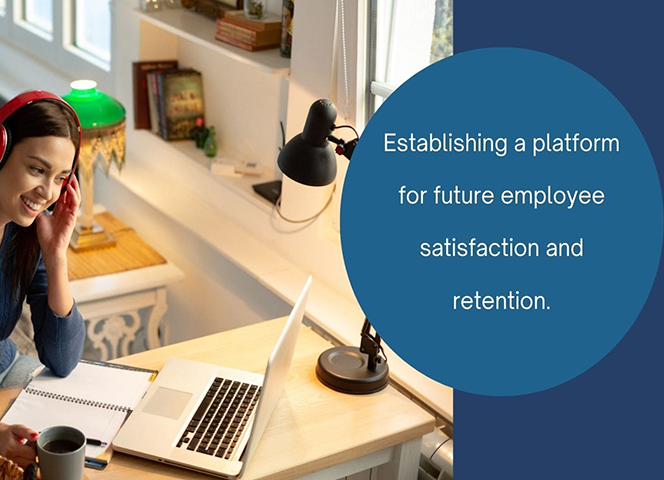The strategy behind remote onboarding
With the widespread adoption of flexible working patterns (such as remote and hybrid working), remote onboarding has become a recognised approach and part of the new ‘normal’. Remote onboarding activities begin as soon as an offer is made to the employee and continues until the employee becomes a productive member of your organisation. But there is a marked difference between onboarding employees in an office location and remote onboarding. The real challenge is to create an atmosphere of harmony on the first day without physical face-to-face interaction with the other employees. Therefore, committing to a well-designed remote onboarding strategy is significantly influential in ensuring the success of remote and hybrid working. Onboarding remotely is a journey for new hires and can last as long as three months for many organisations. It involves presenting well-structured, clear expectations from both them and you as their new employer and should be orderly, straightforward, and easy to follow.
Impact on HR and the wider organisation
The approach and processes to remotely onboard a new employee can affect many aspects of HR and the wider organisation and should therefore be well planned and executed.
- Employee engagement, which acts as a qualitative measure of an employee’s enthusiasm, confidence, eagerness, and productivity, can be significantly influenced through the remote onboarding process, provided that it is a positive experience.
- Executed correctly, remote onboarding can boost an individual’s confidence and create a positive environment and atmosphere from the outset of their employment, contributing to employee performance and thus to the company’s overall goals.
- Onboarding is also a strategic driver in employee retention and can affect employee morale, loyalty, and business efficiency, not to mention the costs incurred in the recruitment process and upskilling of new hires in the long run. In addition, by properly onboarding new employees, they feel that they are appreciated and that you want them and their contributions to your business.
Important considerations
- Remote workers often fear being left out of the team and experience a feeling of disconnect. Therefore, companies should strive to create a friendly and comfortable environment through frequent video calls and web conferences to avoid such situations.
- Grasping an understanding of the company culture is a gradual process, and new hires should have the opportunity to engage with other organisation members to get a feel for this.
- New hires, especially those new to remote or hybrid working, can easily feel isolated during the initial onboarding process, and it is important to ensure that they feel supported.
- Setting expectations at the outset concerning the type and level of support they can expect is crucial.
- Although company onboarding may seem monotonous for most managers, they must understand the importance and impact of the process.
In summary
Creating a successful rollout of remote onboarding establishes an excellent platform for future employee satisfaction and retention. By creating an engaging environment and seamless experience for new hires during remote onboarding, you can make a positive experience from the outset, setting the pace for future performance and productivity.
Traditionally, onboarding (sometimes referred to as organisational socialisation) relates to how new employees acquire the company’s knowledge, skills, tools and cultural understanding to become an effective employee. Onboarding involves a series of steps and activities that allow new hires to get to know their team and learn about the organisational culture, attitudes, methods, rituals, and tools of their new workplace. In addition, it is an opportunity to provide individuals with a clear view of your business’s mission, vision, and goals and how to align themselves with these. This can help them understand how they can contribute to reaching these goals while adhering to the company’s mission and vision.
There must be a seamless transition from contract signing through to your new hire’s actual start day until they are fully established in their role. If done correctly, this can lead to positive job performance, increased employee commitment, a higher company retention rate, and a lower attrition rate.
This post was written by Tugela People. They are an exhibitor on the Consulting & Advisory Partner floor of the HRTech247 Partners Hall here.






